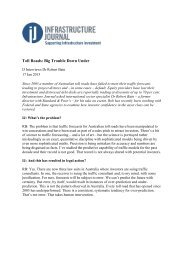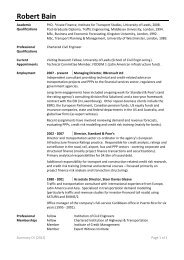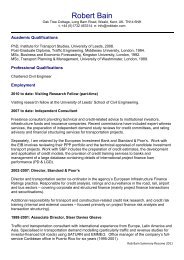Disincentivising overbidding for toll road concessions
Disincentivising overbidding for toll road concessions
Disincentivising overbidding for toll road concessions
- No tags were found...
You also want an ePaper? Increase the reach of your titles
YUMPU automatically turns print PDFs into web optimized ePapers that Google loves.
DISINCENTIVISING OVERBIDDING FOR TOLL ROAD CONCESSIONS<br />
Clear Description of the Product Offering<br />
A number of traffic <strong>for</strong>ecasting reports fail to describe the <strong>toll</strong> facility under consideration in simple terms highlighting<br />
the key characteristics of the project – such as future time savings or improved journey time reliability – that would<br />
attract users. Facilities tend to be discussed in engineering or modelling terms. Investors need to understand what a<br />
<strong>toll</strong> <strong>road</strong> represents to consumers (the product offering); who would use it, why, how, when, <strong>for</strong> what purpose(s) and<br />
so <strong>for</strong>th. Lenders frequently talk about the “traffic story” pointing out that a simple story with an intuitive appeal is<br />
likely to attract a more positive response from credit committees than <strong>toll</strong> facilities (and their attributes) that remain<br />
difficult to comprehend and communicate.<br />
Avoid Over-Emphasis on Supply-Side Issues<br />
Many reports reviewed place considerable emphasis on the ‘supply side’ of transport models, devoting numerous<br />
pages to descriptions of highway networks in the base and future years. In itself, this is not unreasonable, however<br />
rather less attention is often paid to the representations of base and future year demand in the models. Traffic<br />
<strong>for</strong>ecasting is frequently described as being a blend of science and art. Supply side modelling represents the<br />
science. It can be depicted accurately – indeed, with military precision using today’s digital maps – and is generally<br />
uncontroversial. However demand <strong>for</strong>ecasting models are only as strong as their weakest links – and the weakest<br />
links inevitably relate to the ‘art’ of demand representation and the treatment of demand growth. To be of most help<br />
to potential investors, more critical attention needs to be focused on demand side issues, uncertainties and risks in<br />
traffic study reporting.<br />
Avoid Over-Emphasis on a Validated Base Year Model<br />
A well calibrated and validated base year model – one that reflects the travel environment and its competitive<br />
dynamic today – is an important tool <strong>for</strong> <strong>toll</strong> <strong>road</strong> traffic and revenue <strong>for</strong>ecasters; although it is difficult to imagine that<br />
the leading consultancies in this field would struggle to produce validated base year models. This is particularly true<br />
when, as is frequently the case, they limit themselves to relatively straight<strong>for</strong>ward weekday peak-period modelling.<br />
For the investor, however, the construction of a satisfactory base year model is not the end of an important process<br />
– it is the beginning of one. It is the work that follows – focused on the future – that is of most importance. More<br />
emphasis placed on possible future states of the world (and their travel demand and asset usage implications) in<br />
traffic and revenue reports would help to improve credit risk analyst and investor understanding.<br />
Provide a Clear Explanation of the Link Between Traffic and Revenue Forecasts<br />
A number of traffic study reports present their <strong>for</strong>ecasts in terms of aggregate vehicle miles (or revenue miles) <strong>for</strong><br />
future years – or the total number of <strong>toll</strong> transactions (and total <strong>toll</strong> revenues). These output metrics clearly build from<br />
projections of traffic volumes using <strong>toll</strong>ed links in the demand model – however the link volumes themselves are often<br />
not reported. This makes it difficult <strong>for</strong> the reader to understand how future traffic patterns are expected to evolve (in<br />
any detail) and to determine whether – or not – the projections make sense. A clear explanation of how future-year<br />
link volumes translate into project revenues would be of considerable help in this context.<br />
Conduct Comprehensive and Realistic Sensitivity Testing<br />
Most of the reports reviewed present the <strong>toll</strong> revenue results from sensitivity tests – however, frequently, these tests<br />
are limited in both scope and scale. Sometimes they appear to have been ‘cherry picked’ <strong>for</strong> their lack of impact on<br />
future cash flows! Investors need comprehensive sensitivity testing of the key project variables about which there is<br />
uncertainty. These sensitivity tests need to be realistic in terms of the alternative parameter values being evaluated.<br />
Simply reducing an input by 10% (with no explanation or justification provided) does little to enhance investor<br />
confidence. Sensitivity testing needs to respond intelligently, on a project by project basis, to the specific risks and<br />
uncertainties to which financiers may be exposed.<br />
74






